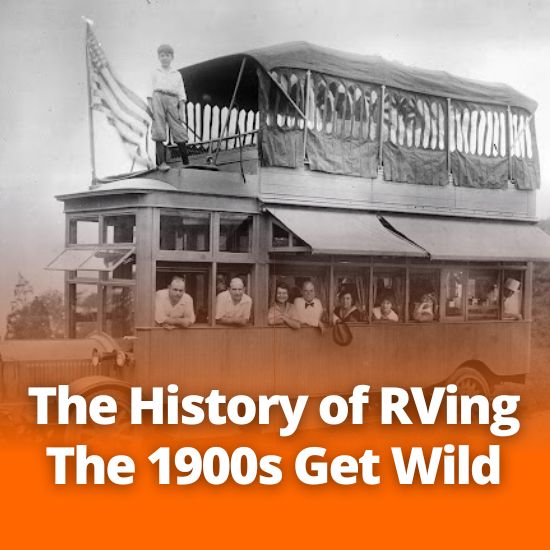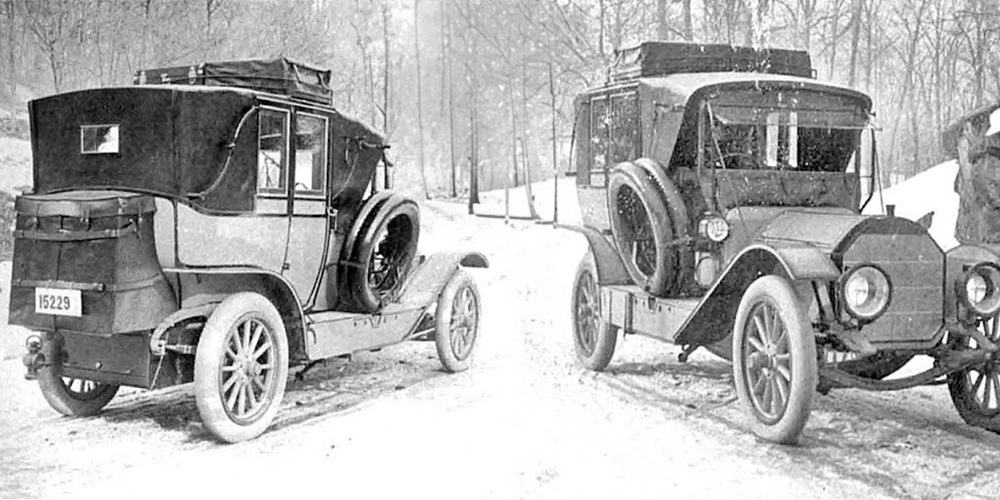
The History of RVing- The 1900s Get Wild
With a love of camping ignited and technology developing for even the most bougie of initiates, and as vehicles became more common and affordable, so did road tripping. We saw the first RVs come to fruition in the 1900s. But they weren’t what you would call “professionally manufactured.” Into the new century, pioneering campers started adding tents, beds, and even toilets, kitchens and sinks with running water to their family cars! In many cases, vehicles had running boards where a large box could be installed that would contain a fold-up cot or kitchen additions to make it more homey. Rear seats would fold out into beds, and many still would tow a wooden trailer with extra supplies. By broad strokes, all very similar to camping in the 2020s. Or so it sounds.
Here’s an Earl Trailer connected to a (model) T Ford, circa 1913, as seen in the RV/MH Hall of Fame. It’s believed to be the oldest travel trailer and was custom built in Los Angeles. It was restored in 1980 for display at the museum.
According to David Woodworth, an RV historian and collector of vintage RVs and memorabilia in the United States, who toured his collection around the States between 1995 and 2006, “The first motorized campers were built in 1910…Before then, people camped in private rail cars that were pulled to sidings along train routes. The year 1910 brought a new freedom to people who didn’t want to be limited by the rail system. RVs allowed them to go where they wanted, when they wanted.”
One of the first RVs to be recognized was based on an automobile in 1904. Built by hand, this early incarnation of a motorhome had bunks for 4, incandescent lights, an icebox, and radio. The next decade was filled with tinkerers with money and time adapting automobiles and truck chassis to create more comfortable RVs, working on a limited wheelbase to create spacious designs. However, they remained rudimentary, these “auto-campers” or “camping trailers” offered minimal comforts compared to those today (or even those that would come in the next few decades). Particularly, you wouldn’t find a bathroom inside, with your options being porta-potty type toilets or “yonder bush” as Woodworth deemed it.
As household income rose, car sales exploded and vacations became more achievable with the middle classes embracing the opportunity. With RVs beginning to become available commercially in the 1910s, no longer was it only the handy few able to afford this traveling lifestyle, opening a wider audience to a new freedom away from the limitations of rail travel.
Commercially Produced RVs Hit the Market

Everyone say hello to the primordial luxury RV known as the 1910 Pierce-Arrow Touring Landau, the first of its kind to hit production lines and at the times of its creation: the height of camping luxury. Similar to the Class B’s of today, the Touring Landau boasted hot amenities such as seats for 7 passengers, the rear of which folded down into a bed, fold-down sink with pressurized tank, and a toilet! (Well, more like a chamber pot but it was the first to actually have some kind of toilet built-in so we’ll take the wins where we can get them). And it came at the time when those who could afford such a luxury vehicle usually brought along ‘the help,’ so the front where the driver was located was separated by a partition; passengers in the back could communicate with them via a telephone.
As the first decade of the century closed, the modernization of camping continued to accelerate.
Although, people still continued to adapt their own vehicles into the 20s. Much like those trendy “I converted an old school bus into a mini-house” YouTube videos of today, these vintage converts would add rolled up tents and storage boxes to the rear of the family car, or convert a bus into a motorhome. Unlike the aluminum and fiberglass builds of the future, wood was the primary working material.
DIY-ers continued their daring builds, adding bedrooms, kitchenettes (with fridge), water pumps, sinks, showers/tubs, wardrobes, box springs and mattresses, window awnings, curtains, and screens. Some even had electric lights or a telegraph line hook-up!
1915
This was a big year for RVs and the budding community of passionate travelers. It was the year the Lamsteed Kampkar was invented by Samuel B. Lambert (of the Listerine Lambert Family, yes, the family that brought you mouthwash also brought you one of the first motorhomes, seriously). This minty-fresh design fit on a Ford chassis, with sides that folded down, seat and side cushions combining to make a 42-inch wide bed on either side of the car!
1915 also brought the famous Conklin Gypsy Van – probably the most well-known vintage motorhome thanks to its ostentatious design and featuring in many newspapers at the time as they made their trek through America.

This manufacturing marvel was custom built by Roland Conklin’s Gas-Electric Motor Bus Company, was 25-feet long, fully-furnished, and had two floors! The Conklin bus proved that luxury was capable of a motorhome, through more than extended tents from the back or sides; this was an apartment on wheels! Not only did it have bunks for the 11 original party members (husband, wife, two kids, two nephews, a friend, a governess, a cook, and two chauffeurs – yeah, imagine packing that kind of entourage), but an electric generator, folding table and desk, concealed bookcase, phonograph, convertible sofas, small appliances, and a “roof garden.”
It displayed the true capabilities and appeal of motorhomes and trailers as an alternative to “roughing it” camping. It also introduced the concept of an easy set-up. Just like pop-up trailers today, car campers still required a tent set up along with a kitchen, preparing bedding, and a dozen other nuances. Whereas the motorhome camper carried all of this along without a complex unpacking and set-up routine.
The following years were a landslide of RV improvements and development. In 1916, Gustau de Bretteville, a San Francisco businessman, manufactured the “Telescoping Apartment,” built on a Ford Model T Runabout. (Images featured are of an accurate replica)


The name would imply that it’s something out of The Jetsons, but it was actually relatively small with a back portion that dropped out to make a slim two-person bed, pantry, chest of drawers no larger than a side table, a portable shower that used hot water from the engine, and a stove that mounted on it.
1917
So we’ve had commercial businesses, home DIYers, now we have an aviator: Glenn Curtiss, who built a fifth-wheel he coined as a “motor bungalow” out of plywood on a spruce frame. Spacious, it had canvas tilt-out beds and was revamped in 1928 to become the “Aerocar Land Yacht.”
1917 was also the year Earle C. Anthony in Los Angeles converted a 25-foot Packard bus into a motorhome with some of the most modern finishes we’ll see this decade: convertible sofas, galley, two-burner gas stove-top, ice box and sink, and a water closet with a toilet. It could even hook into a telegraph line!
